#Jeanne Ann Childs
Text
Jerry Westrom biography: 13 things about Isanti, Minnesota man
Jerry Westrom biography: 13 things about Isanti, Minnesota man
Jerry Arnold Westrom is a former businessman from Isanti, Isanti County, Minnesota, United States. He once owned a pair of Westrom’s Corner gas stations and a Sears appliance store.
Aside from Isanti, Westrom has also lived in other parts of Minnesota including Waite Park, Grant, Elbow Lake, Cambridge and Minneapolis. He previously lived in Osceola, Wisconsin, USA, as well.
Westrom has three…

View On WordPress
0 notes
Text
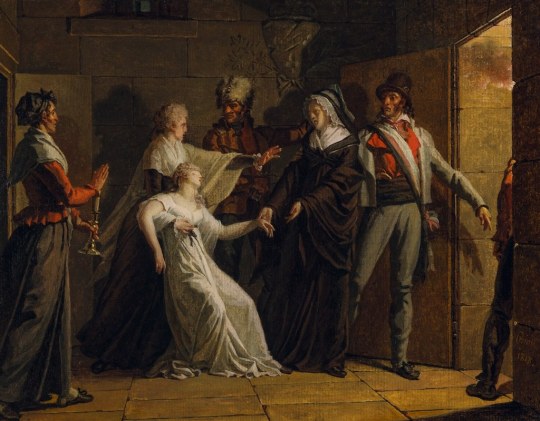
Jacques Augustin Pajou - Marie Antoinette séparée de sa famille au temple - 1818
Marie Antoinette (Marie Antoinette Josèphe Jeanne; 2 November 1755 – 16 October 1793) was the last queen of France prior to the French Revolution. She was born an archduchess of Austria, and was the penultimate child and youngest daughter of Empress Maria Theresa and Emperor Francis I. She became dauphine of France in May 1770 at age 14 upon her marriage to Louis-Auguste, heir apparent to the French throne. On 10 May 1774, her husband ascended the throne as Louis XVI and she became queen.
As queen, Marie Antoinette became increasingly unpopular among the people; the French libelles accused her of being profligate, promiscuous, having illegitimate children, and harboring sympathies for France's perceived enemies, including her native Austria. She was falsely accused in the Affair of the Diamond Necklace, but the accusations damaged her reputation further. During the French Revolution, she became known as Madame Déficit because the country's financial crisis was blamed on her lavish spending and her opposition to social and financial reforms proposed by Anne Robert Jacques Turgot and Jacques Necker.
Several events were linked to Marie Antoinette during the Revolution after the government placed the royal family under house arrest in the Tuileries Palace in October 1789. The June 1791 attempted flight to Varennes and her role in the War of the First Coalition were immensely damaging to her image among French citizens. On 10 August 1792, the attack on the Tuileries forced the royal family to take refuge at the Assembly, and they were imprisoned in the Temple Prison on 13 August. On 21 September 1792, the monarchy was abolished. Louis XVI was executed by guillotine on 21 January 1793. Marie Antoinette's trial began on 14 October 1793; she was convicted two days later by the Revolutionary Tribunal of high treason and executed, also by guillotine, at the Place de la Révolution.
Jacques-Augustin-Catherine Pajou (27 August 1766, Paris - 28 November 1828, Paris) was a French painter in the Classical style.
12 notes
·
View notes
Text
The napoleonic marshal‘s children
After seeing @josefavomjaaga’s and @northernmariette’s marshal calendar, I wanted to do a similar thing for all the marshal’s children! So I did! I hope you like it. c:
I listed them in more or less chronological order but categorised them in years (especially because we don‘t know all their birthdays).
At the end of this post you are going to find remarks about some of the marshals because not every child is listed! ^^“
To the question about the sources: I mostly googled it and searched their dates in Wikipedia, ahaha. Nevertheless, I also found this website. However, I would be careful with it. We are talking about history and different sources can have different dates.
I am always open for corrections. Just correct me in the comments if you find or know a trustful source which would show that one or some of the dates are incorrect.
At the end of the day it is harmless fun and research. :)
Pre 1790
François Étienne Kellermann (4 August 1770- 2 June 1835)
Marguerite Cécile Kellermann (15 March 1773 - 12 August 1850)
Ernestine Grouchy (1787–1866)
Mélanie Marie Josèphe de Pérignon (1788 - 1858)
Alphonse Grouchy (1789–1864)
Jean-Baptiste Sophie Pierre de Pérignon (1789- 14 January 1807)
Marie Françoise Germaine de Pérignon (1789 - 15 May 1844)
Angélique Catherine Jourdan (1789 or 1791 - 7 March 1879)
1790 - 1791
Marie-Louise Oudinot (1790–1832)
Marie-Anne Masséna (8 July 1790 - 1794)
Charles Oudinot (1791 - 1863)
Aimee-Clementine Grouchy (1791–1826)
Anne-Francoise Moncey (1791–1842)
1792 - 1793
Bon-Louis Moncey (1792–1817)
Victorine Perrin (1792–1822)
Anne-Charlotte Macdonald (1792–1870)
François Henri de Pérignon (23 February 1793 - 19 October 1841)
Jacques Prosper Masséna (25 June 1793 - 13 May 1821)
1794 - 1795
Victoire Thècle Masséna (28 September 1794 - 18 March 1857)
Adele-Elisabeth Macdonald (1794–1822)
Marguerite-Félécité Desprez (1795-1854); adopted by Sérurier
Nicolette Oudinot (1795–1865)
Charles Perrin (1795–15 March 1827)
1796 - 1997
Emilie Oudinot (1796–1805)
Victor Grouchy (1796–1864)
Napoleon-Victor Perrin (24 October 1796 - 2 December 1853)
Jeanne Madeleine Delphine Jourdan (1797-1839)
1799
François Victor Masséna (2 April 1799 - 16 April 1863)
Joseph François Oscar Bernadotte (4 July 1799 – 8 July 1859)
Auguste Oudinot (1799–1835)
Caroline de Pérignon (1799-1819)
Eugene Perrin (1799–1852)
1800
Nina Jourdan (1800-1833)
Caroline Mortier de Trevise (1800–1842)
1801
Achille Charles Louis Napoléon Murat (21 January 1801 - 15 April 1847)
Louis Napoléon Lannes (30 July 1801 – 19 July 1874)
Elise Oudinot (1801–1882)
1802
Marie Letizia Joséphine Annonciade Murat (26 April 1802 - 12 March 1859)
Alfred-Jean Lannes (11 July 1802 – 20 June 1861)
Napoléon Bessière (2 August 1802 - 21 July 1856)
Paul Davout (1802–1803)
Napoléon Soult (1802–1857)
1803
Marie-Agnès Irma de Pérignon (5 April 1803 - 16 December 1849)
Joseph Napoléon Ney (8 May 1803 – 25 July 1857)
Lucien Charles Joseph Napoléon Murat (16 May 1803 - 10 April 1878)
Jean-Ernest Lannes (20 July 1803 – 24 November 1882)
Alexandrine-Aimee Macdonald (1803–1869)
Sophie Malvina Joséphine Mortier de Trévise ( 1803 - ???)
1804
Napoléon Mortier de Trévise (6 August 1804 - 29 December 1869)
Michel Louis Félix Ney (24 August 1804 – 14 July 1854)
Gustave-Olivier Lannes (4 December 1804 – 25 August 1875)
Joséphine Davout (1804–1805)
Hortense Soult (1804–1862)
Octavie de Pérignon (1804-1847)
1805
Louise Julie Caroline Murat (21 March 1805 - 1 December 1889)
Antoinette Joséphine Davout (1805 – 19 August 1821)
Stephanie-Josephine Perrin (1805–1832)
1806
Josephine-Louise Lannes (4 March 1806 – 8 November 1889)
Eugène Michel Ney (12 July 1806 – 25 October 1845)
Edouard Moriter de Trévise (1806–1815)
Léopold de Pérignon (1806-1862)
1807
Adèle Napoleone Davout (June 1807 – 21 January 1885)
Jeanne-Francoise Moncey (1807–1853)
1808: Stephanie Oudinot (1808-1893)
1809: Napoleon Davout (1809–1810)
1810: Napoleon Alexander Berthier (11 September 1810 – 10 February 1887)
1811
Napoleon Louis Davout (6 January 1811 - 13 June 1853)
Louise-Honorine Suchet (1811 – 1885)
Louise Mortier de Trévise (1811–1831)
1812
Edgar Napoléon Henry Ney (12 April 1812 – 4 October 1882)
Caroline-Joséphine Berthier (22 August 1812 – 1905)
Jules Davout (December 1812 - 1813)
1813: Louis-Napoleon Suchet (23 May 1813- 22 July 1867/77)
1814: Eve-Stéphanie Mortier de Trévise (1814–1831)
1815
Marie Anne Berthier (February 1815 - 23 July 1878)
Adelaide Louise Davout (8 July 1815 – 6 October 1892)
Laurent François or Laurent-Camille Saint-Cyr (I found two almost similar names with the same date so) (30 December 1815 – 30 January 1904)
1816: Louise Marie Oudinot (1816 - 1909)
1817
Caroline Oudinot (1817–1896)
Caroline Soult (1817–1817)
1819: Charles-Joseph Oudinot (1819–1858)
1820: Anne-Marie Suchet (1820 - 27 May 1835)
1822: Henri Oudinot ( 3 February 1822 – 29 July 1891)
1824: Louis Marie Macdonald (11 November 1824 - 6 April 1881.)
1830: Noemie Grouchy (1830–1843)
——————
Children without clear birthdays:
Camille Jourdan (died in 1842)
Sophie Jourdan (died in 1820)
Additional remarks:
- Marshal Berthier died 8.5 months before his last daughter‘s birth.
- Marshal Oudinot had 11 children and the age difference between his first and last child is around 32 years.
- The age difference between marshal Grouchy‘s first and last child is around 43 years.
- Marshal Lefebvre had fourteen children (12 sons, 2 daughters) but I couldn‘t find anything kind of reliable about them so they are not listed above. I am aware that two sons of him were listed in the link above. Nevertheless, I was uncertain to name them in my list because I thought that his last living son died in the Russian campaign while the website writes about the possibility of another son dying in 1817.
- Marshal Augerau had no children.
- Marshal Brune had apparently adopted two daughters whose names are unknown.
- Marshal Pérignon: I couldn‘t find anything about his daughters, Justine, Elisabeth and Adèle, except that they died in infancy.
- Marshal Sérurier had no biological children but adopted Marguerite-Félécité Desprez in 1814.
- Marshal Marmont had no children.
- I found out that marshal Saint-Cyr married his first cousin, lol.
- I didn‘t find anything about marshal Poniatowski having children. Apparently, he wasn‘t married either (thank you, @northernmariette for the correction of this fact! c:)
#Marshal‘s children calendar#literally every napoleonic marshal ahaha#napoleonic era#Napoleonic children#I am not putting all the children‘s names into the tags#Thank you no thank you! :)#YES I posted it without double checking every child so don‘t be surprised when I have to correct some stuff 😭#napoleon's marshals#napoleonic
70 notes
·
View notes
Text
Timeless Woman Series-Carolyn Bessette Kennedy

Welcome to Vivacious Officiall
Today we will be kickstarting The Timeless Woman series with a case study on the one & only Carolyn Bessette Kennedy.
Many of you may already know of Carolyn due to her huge impact on fashion & her marriage to John F Kennedy Jr.
However in this blog post we will be deep diving into Carolyn’s life & how she was the ultimate timeless woman.
BACKSTORY

Carolyn Jeanne Bessette was born January 7th 1966 to Catholic parents William & Anne. As the youngest child in her family, she had two older sisters, Lauren & Lisa. They lived in White plains, New york
After her parents divorced when Carolyn was eight years old, she relocated to Connecticut to continue schooling.
As a natural-born star at St Barths High School, she gained attention for her unique personality and style, earning her the title of the Ultimate Beautiful Person
Carolyn went on to attend Boston University and worked briefly as a Model and in Event management before working for Calvin Klein.
CALVIN KLEIN ERA
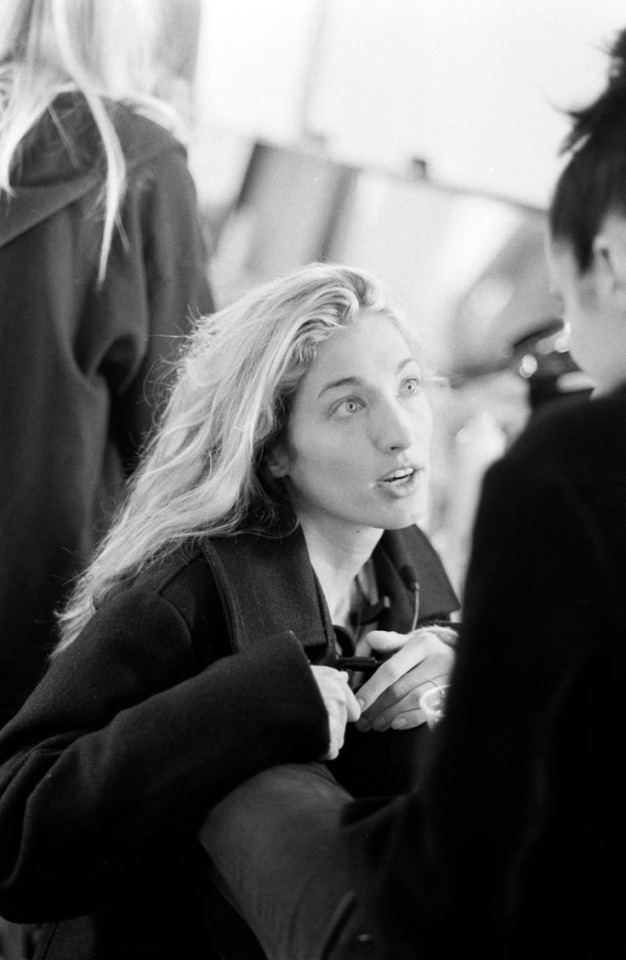
Carolyn began her career in the fashion industry working for Calvin Klein as a sales assistant. Naturally it didn’t take long before she began dominating in her field.
“One of her responsibilities at the shows is to manage the models. They are constantly, it seems, in crisis. She is mother to them all, calm and ready with answers.” - Carole Radizwell, What Remains.

Carolyn's elegant yet chic style, combined with her outstanding work ethic, earned her a promotion to Director of Publicity and a transfer to the office in Manhattan, New York.
Where she met the one & only… John F. Kennedy Jr
Lesson 1: As a woman, it is important to have your passions and learn how to network. Don’t wait for a man to come give you the life you rightfully deserve. The best time to meet a high value man is when you are already in love with your life.
JFK & CAROLYN
JFK Jr was the son of the 35th president of the United States, John F. Kennedy
This man represented American royalty as well as being the finest eligible bachelor of his day. He had wealth, power, and extraordinary charisma.
& he was crazy about Carolyn.
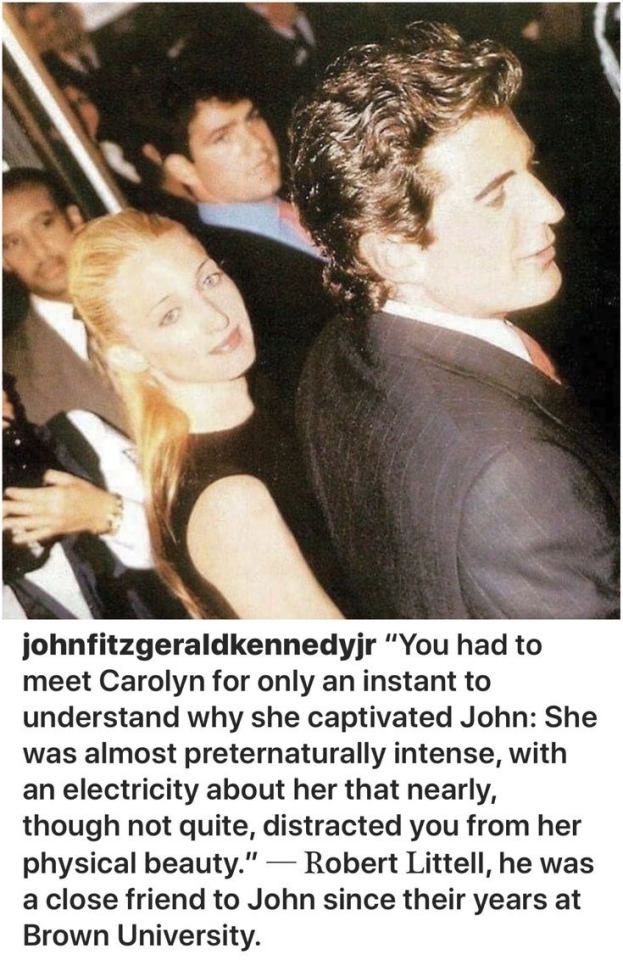
Carolyn reportedly turned down JFK Jr. several times because she did not want the media's attention. This naturally increased his interest in her, and he pursued her until they began dating and eventually married on September 21, 1996, in Cumberland Island off the coast of Georgia.
Lesson 2: As a high-value woman, you will naturally attract high-quality men who are accustomed to women throwing themselves at them. Never do this. Your standards apply to all men. This will earn you respect and even more admiration from your suitor.
Side note : Women that throw themselves at successful men are women hoping to leech off his success. Men are not dumb. The best kind of woman to this type of man is a woman that acknowledges his success but does let that be a free pass.
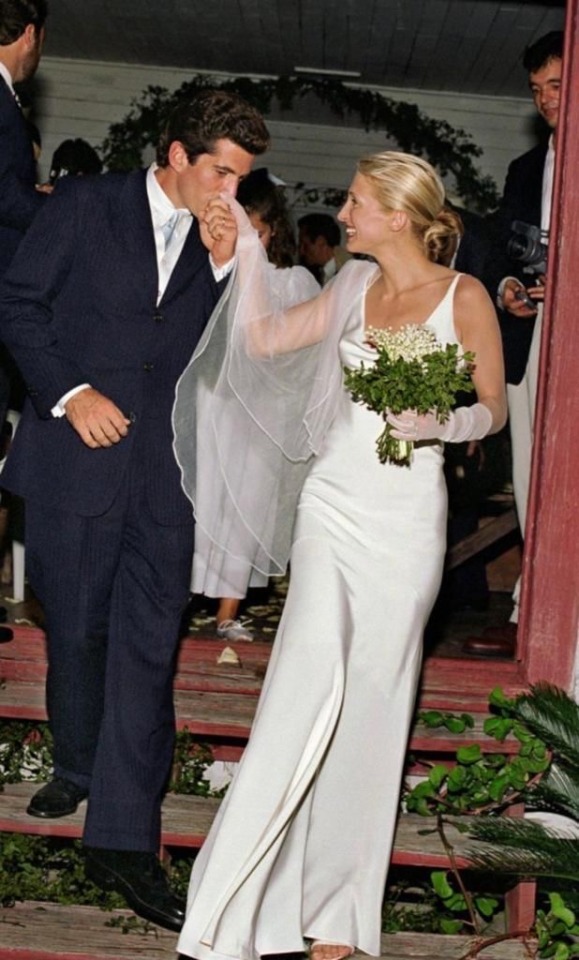
Just like all marriages, John & Carolyn had their differences. Carolyn despised the attention. She was frequently trailed by paparazzi and called derogatory names in order to elicit a reaction from her. This put significant strain on their marriage. Regardless, it was clear that they loved each other and were prepared to work it out.
Unfortunately, in 1999, John, Carolyn, and Lauren (Carolyn's sister) were killed in a plane crash off the coast of Massachusetts owing to terrible weather. May their souls rest peacefully.
Carolyn's life was cut short, but she is remembered as a loving, passionate, beautiful sister, daughter, and wife.
Final Lesson: Ladies, it is critical that you leave a legacy. The world needs more powerful women who set their own rules. To inspire your children, grandchildren, and the countless women who will come after you.
xoxo, Vivacious
#divine feminine#femininity#high value woman#spirituality#high maintenance#high standards#black girl luxury#feminine journey#goddess#self love
12 notes
·
View notes
Text
Random thought on mlb theories (Part-1)
(Not all of them are mine, some of them I included cause I wanted to share my thoughts. Credits to original creator for their brilliance)
1. So we all know how Lila took the miraculous of butterfly when it fell . What if she knows that Marinette is ladybug!!? Why I think that is cause Marinette detransformed while talking to Gabriel. There are chances that she might have seen that
2. We also know that Felix and kagami know Marinette's true identity. Will Marinette get to know about it?
3. This one is connected with number 2, so I saw some people saying that we all know how Felix transformed from villian-antihero-hero. There are chances that he might team up with Lila (who is now Hawk moth) .
4. I wonder why Lila wants the miraculous of butterfly? Is she going to have the same motive as Gabriel? Just taking ladybug and cat noir's miraculous? If it is , why does she need it? And if it isn't what's the other motive then?
5. I also wonder if kagami's mom is really blind or is she just pretending? There have been moments when I thought she isn't blind.
6. (continuing number 1) If Lila knows/gets to know that Marinette is ladybug, she is going to everything to destroy her reputation. She can manipulate Parisians and everyone at the school. It would be the hardest time of all and if during that time Adrien gets to know that she was hiding Gabriel's secret from him, it will not end well. Just the thought of it makes my body shiver.
7. I have also seen people saying that the miraculous of peacock broke bcz Emilie tried to make 2 sentimosters at the same time. He was supposed to get a twin sister but that failed somehow and Adrien was the second. His name was also not supposed to Adrien ,his name was taken out of his dead twin sister who was named Adrienne and once Gabriel and Emilie got to know that he was connected to both amoks. Some people partially think that his named was being Celeste, which is a unisex name in France .
8. Some people also say that Anne-Jeanne Theoxanne du Bocquale is a time traveling adopted daughter of Adrienette. What I think is that could be true cause apparently Adrien is a sentimonster (that's what we think even though it's not confirmed) and sentimoster's can't reproduce. So maybe they decided to adopt a child but I am not so sure about the time travelling thing .
9. Adrien is going to intern at the Dupain-Cheng bakery. It will not end well. Ok well, I got nothing much to say about it but my question is why would he?
10. Some of you guys think that Kagami is meant for Adrien. Like why guys? Tbh when they started dating I didn't really like it . From the very start I always thought Marinette was the one who is made for Adrien. Why? Bcz no one can understand him better than her and not to mention no one can know his schedule for next several years and no one can stalk him better .
11. I have also read this theory where people say that Felix was created out of jealousy over Gabe and Emilie's conception of Adrien, which means it's possible he doesn't love Kagami for herself or the fact they "are the same," . I mean this could be true and credits to the original person who thought of this amazing theory like idk where u guys get these from , hats off!
12. Next theory is , The ring Felix gave Kagami isn't actually her amok, but an identical copy. I agree bcz we have seen Felix talking about how he felt when he was being controlled so it’s most likely to be true cause he wouldn’t want kagami to feel the same way (if he really loves and her cares about her)
13. I also wonder when and how Felix will tell Adrien about how both of them are sentimonsters and were created using a miraculous and if he tells it before he gets to know Gabriel’s truth it is most likely to be that Adrien will suspect that his own father was the villain .
14. This one is not really a theory but like I wonder Has/Will ladybug told cat noir about the true identity of monarch? If we look at the last scene from Re-creation they both seem pretty normal like always . So that could mean that she still hasn’t revealed it yet . Do you guys think she will?
15. There’s also this thing that Felix might team up with Lila cause of his character arc . You see , he was seen first as a villain then as an anti hero and then a hero . This will be a direct parallel to Adrien's character arc.
16. Ladybug giving up the guardian role to Luka and Cat Noir will help her recover her memories. Umm…. I mean we all know that Marinette will do/have to do this but I don’t think it will be Luka or maybe it can be , I just don’t know .
17. Lila will tell Adrien the truth about Gabriel and get mad at Ladybug then get akumatized . Well she is lie-la so for sure but wasn’t she going to be changing her look?
18. Marinette will slowly have suspiciousness about “cerise” as she sees her. Well cerise is new look of lie-la but she is still the same from inside and marinette’s also clever enough to point her lies out .
19. Kagami’s mom (I forgot her name) is gonna help Lila . Bcz the thing she wanted (which was probably Adrien and kagami being eternal couples or whatever) is still a dream .
20. Felix will find out cat noir is Adrien by sensing the amok on cat noir . I don’t think so bcz Felix has came over cat noir a couple times but he didn’t sense that .
#miraculous ladybug#marinette dupain cheng#miraculous fanart#mlb fandom#adrien agreste#miraculous adrien#miraculous les aventures de ladybug et chat noir#tales of ladybug and cat noir#ml ladybug#mlb season 6#mlb theory#miraculous tales of ladybug and chat noir#felix fathom#miraculous felix#felinette#kagami tsurugi#ladybug and chat noir#adrienette#mlb
10 notes
·
View notes
Note
can you do a longlist of the books about strong girl protags and female friendships, etc. that were really impactful/your favorites so i know what to gift/rec any young girls in my life?
aww!! i would literally love nothing more than to compile such a list ty anon. i tried to put them in an order vaguely representative of youngest audiences to older...i'm not sure how well some of these would hold up in 2023 but they're all ones i remember enjoying and having an impact on me somehow...
not one damsel in distress by jane yolen
the daring book for girls by andrea j. buchanan & miriam peskowitz
the whole dear america series!!!!!!!!!!!!!
the ordinary princess by m. m. kaye
the caddie woodlawn series by carol ryrie brink
walk two moons by sharon creech (i used to have whole passages of this book memorized because i read it so often...potentially the most formative one on this list)
because of winn-dixie by kate dicamillo
the scholastic encyclopedia of U.S. women by sheila keenan (my elementary school art teacher had this book in her classroom library and i remember flipping through it when i was hanging around after school while my mom was doing PTA stuff...it was the first time i'd heard of so many of those women and further stoked my interest in history. i remember being so disturbed [and also intrigued] by the entry about ethel rosenberg specifically. i'm sure there are more updated versions of the book but this is the particular edition i remember reading.)
the penderwick sisters series by jeanne birdsall
bloomability by sharon creech
everything on a waffle by polly horvath
the tracy beaker series by jacqueline wilson
the outcasts of 19 schuyler place by e. l. konigsburg (also extremely formative)
saffy's angel / the whole casson family series by hilary mckay (i used to carry these books around with me as if they were security blankets)
p.s. longer letter later and snail mail no more by paula danziger & ann m. martin
the secret language of girls by frances o'roarke dowell
the tail of emily windsnap by liz kessler
savvy by ingrid law
love, stargirl by jerry spinelli (idk if any book had more of an impact on me as a child tbh like this rocked my world so completely i still think about it/quote it all the time. i know a lot of people read stargirl in school and honestly i don't think it's that good but the sequel is so underrated. so read it.)
a perfect gentle knight by kit pearson
feathers by jacqueline woodson
habibi by naomi shihab nye
the anastasia krupnik series by lois lowry
criss cross by lynne rae perkins
ella enchanted by gail carson levine........OBVIOUSLY
esperanza rising by pam muñoz ryan
kira-kira by cynthia kadohata
the city of ember by jeanne duprau
bad girls by cynthia voigt (tbh i REALLY don't know how this one holds up but i remember thinking it was pretty edgy as a kid)
little women by louisa may alcott
hurt go happy by ginny rorby
persepolis by marjane satrapi (obviously for slightly older readers)
the aforementioned rookie yearbook, natch. (also older)
10 notes
·
View notes
Text
Anne-Jeanne Theoxanne du Bocquale is a time traveling adopted daughter of Lukadrien Adrienette
This is the first of my crack theories I've decided to tackle, is very much a major crack theory.
I have no actual proof of anything, except that:
According to this now deleted interview that can be read via Internet Archive, Wilfried Pain tells a fan that there would be a new character from the future.
The Fandom Wiki seems to think this interview is discussing season 5, but after some back and forth with a mutual, we've come to the conclusion that it's actually discussing season 4, which just so happens to be the season that Anne-Jeanne is introduced.
I've seen multiple posts of people noticing that she has quite a bit more detail than you'd expect for a small side character. She doesn't look out of place at all next to our main girl Maribug, which you can't say for a lot of the designs of minor characters.
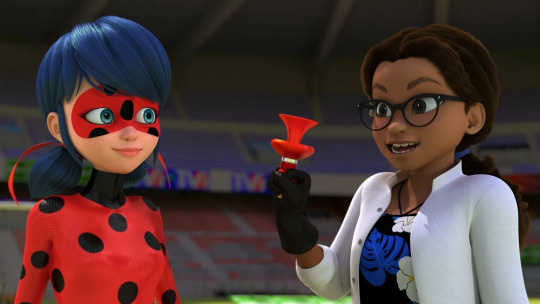
She was slotted to be a teacher to the kids in season 5, but apparently that was scrapped. Perhaps she'll be a teacher in the new school for season 6?
As for being Lukadrien's Adrienette's daughter...
The fandom wiki claims that the vision of a T-Rex Ladybug sees in the Burrow during Chat Blanc is foreshadowing of Anne-Jeanne's existence. I'm a bit skeptical on this, but Anne-Jeanne would have needed to somehow get DNA in order to bring the T-Rexes back to life, and in Time Tagger adult Bunnyx has a pet T-Rex named Denver.
Anne-Jeane is officially introduced in season 4's Hack-San, an episode that irrevocably fractures the LadyNoir partnership.
She shows up again in Rocketear, another episode that kicks LadyNoir while it's down. (After wrangling her T-Rexes, she says she's not really sure what to do with them, and wonders if it was really a good idea to bring them back to life... Kind of an ominous statement for a show where the deuteragonist is a boy born of magic, and whose creation caused the events of literally everything in the show.)
She has a short mention in Jubilation, where her T-Rex pigeon hybrids escape and go on a rampage. Nadja Chamack asks if she has gone too far with her science creations? Another ominous statement.
It's important to note, that Ladybug accidentally wears her friend's Alliance ring while capturing the hybrid dinosaurs, and thus, gets her friend who has been pretending to be Ladybug in hot water for possibly actually being Ladybug. It's interesting that Monarque doesn't even know Socqueline was impersonating a hero, he just sees her name in the Alliance alerts and goes after her. Of course Maribug thinks it's because she's been cosplaying being a hero and Monarque found out!
Anyway, I want to make a point that the dream sequence in Jubilation is very odd. It doesn't read to me as anything other than a child's idea of what love and marriage is. For one, both French citizens and foreigners need an entire forest of identification documentation, and they need to be married at a town hall in order to be legally binding. Only then can a religious ceremony take place. Obviously Ladybug and Chat Noir cannot do that, so they are only symbolically married at a church. The babies the couple are, for lack of better words, in possession of are inanimate dolls. There's a strange haze around the entirety of the dream sequence, just like the strange haze of the season 5 finale.
One of these days I'll do a line by line rundown of the Jubilation dream sequence, but that isn't the point I'm trying to make here. The point is this: the juxtaposition of Anne-Jeanne, the actual future daughter being the catalyst for whatever the hell Jubilation was, would be *chefs kiss* excellent storytelling.
FINALLY we have the final episode of season 5: Re-Creation. Anne-Jeanne makes a cameo in an interview where she gives an ominous message:
"We all remember the worldwide nightmare epidemic followed by the victory of Ladybug over Monarch...and how the swarm of magic ladybugs swarmed the planet to repair everything and free us. This even raised global awareness. We humans have accomplished incredible things throughout history. But still, we often fall victim to our emotions, because no one teaches us how to understand or deal with them... If we don't listen to what our fears, sadness or anger are trying to tell us—
Alya turns off the monitor, and the audience doesn't hear the lesson Anne-Jeanne is trying to convey. Gabemoth had taken advantage of negative emotions in order to akumatize his victims. Presumably, future Lilamoth will do the same.
The Paris special made it very clear that our universe Adrien is just distracting himself from his grief. Bottling up and ignoring doesn't do any good. He can avoid his hurt all he wants, but it's not getting to the core issue. He needs to address his emotions in order to heal.
More propaganda!
Anne-Jeanne's dress has moonflowers on it! Guess who loves flowers and has a lot of baggage concerning the moon! Yes, that's right, our boy Adrichat! Once again, Adrien being represented by the moon is a post for another day, BUT I DIGRESS.
Plagg is the reason the dinosaurs are extinct, and has a very particular grudge against T-Rexes in particular. Well, AnneJeanne brought the T-Rexes back to life!
More of a "Lukadrien's daughter headcanon", but I think Anne-Jeanne would be using a fake name if she's actually time traveling. I like the name Aurora because Luka's hero name Viperion is based off of Hyperion, the father of the dawn who was named Eos. Eos' Roman name is Aurora. Funnily enough, I checked the Luka Couffaine tag tonight and someone else thought his daughter would be named Aurora. I promise it was just a coincidence we both came up with this name! It also sticks to the Couffaine naming tradition of ending in "A", so it's still a pun on the French acouphène :D
#miraculous ladybug#marinette dupain cheng#adrien agreste#cat noir#chat noir#miraculous ladybug season 6#luka couffaine#anne-jeanne theoxanne du bocquale#miraculous ladybug theory#mlb theory#ml theory#meta#love square#ladynoir#adrinette#adrienette#lukadrien
7 notes
·
View notes
Text
Charles never became Jean-Baptiste 2.0
It’s more complicated
Yes...You read it correctly. Charles didn't instantly became like his father after having sex, and in fact, he never did, and no, this isn't a product of classic toxic masculinity.
So...Character backstory, from what we see
We know that he grew up to be a very empathetic child. He also spent an unspecified amount of time (probably a few months or even years) faking his identity in a boarding school out of all places. Plus, given the educational methods of the time, he would have been highly encourage to re-sensitize himself to shame and basically...embrace his social needs or collect a beating. At least it's what I could get from sources on education from this time period. Also, showing desire for social integration is a basic human instinct, and so, I don't think he'll even need the threat of corporal punishment to motivate him into it, but would also contribute to further weaken his sense of self by allowing him to forget his identity. https://www.google.ca/books/edition/L_universit%C3%A9_de_Paris_et_les_j%C3%A9suites/5ADQAAAAMAAJ?hl=fr&gbpv=1&dq=ch%C3%A2timents+corporels+chez+les+j%C3%A9suites&pg=PA158&printsec=frontcover
After his expulsion, Charles-Henri was given a privet tutor: Grisel, who became one of the closest person of his life...And he lost him at age 14.
So, the Charles we meet in volume one already has lived through a lot of grief, and has a sense of self already very fragile, from the constantly switching system of values he would have to adapt to for anything from 2 to 4 years, at the formative age of early adolescence.
Now, let us take a look at Innocent, volume per volume 1-2, of how Charles felt into this.
Vol 1 of Innocent:
Oh, here we have in the first pages father and son walking to get a letter of recommendation. On the way, the people walk away from them, pass waters to "purify" the street after their passage. The reason for this "pleasant little walk" is so Jean-Baptiste could ask for a letter of recommendation for a school in Toulouse.
(Side note, this is either a mistake, as in Sakamoto-sensei not knowing the situation of executioners was different in Southern France than in Northern France, or it's absolutely brilliant characterization if intentional, but the choice of city seems to be a mistake, because non of the characters seem particularly nervous at the idea of going there)
Anyway, so the Prévot des Marchands gives said recommandation letter to Jean-Baptiste, but instead of giving it to him in hand, he drops it on the floor for him to pick it up. Jean-Baptiste absolutely does not respond to this attempt at humiliation, and scolds his son for not thanking the Prévot properly, and not keeping his posture strait.
This could hint at a father-son conflict, and Jean-Baptiste, given the context mentioned above, has reasons to believe Charles is putting up a manipulative act, if he knows about the Jesuit education methods, but he would surely know how "norm" of the time felt entitled to treat people who where considered shameless. Since, at this point, Jean-Baptiste still doesn't plan to train Charles as an executioner, it is probably the main thing creating tension. It's probably a situation of "One, no, I will not go softer on you just because you act all sheepish, two bowing your head in humiliation is beneath you, man up and three, I am not so unreasonable as to whip you for not bowing your head and blushing on command."
But, from Charles' perspective, he is humiliated and just, emotionally exhausted. Plus, from his point of view, his father's scolding doesn't make logical sense, since why is he reproaching him for acting like a socially integrated person if he's about to send him to an establishment for socially integrated people.
Once they are at home, the rest of the family joins in on the entire thing, and Anne-Marthe and Jeanne show themselves to be a lot more coherent and reasonable, not necessarily ethical, but sensible, and reason that since Charles doesn't want to go to school anymore, because of the non-stop heartbreak it lead, he should contribute to the family by becoming his father's apprentice. Charles, who's strongly opposed to killing people, throws a temper tantrum at this (and is probably already frustrated by the humiliation of being shooed out of the streets and his father's contradictory directives) and burns the table cloth.
As a response of his refusal and temper tantrum, Jean-Baptiste tortures his son. However, the frame leading up to the torture scene is quite...stricking. Jean-Baptiste strait up commands Charles to go into the room. There's no lying, there's no tricking, no asking, it's sheer intimidating posture. Oddly enough, even if his gesture is commanding, it is not necessarily rude, he uses his hand to indicate where he expects Charles to go instead of his finger, almost as if inviting him to the torture chamber. This is a behavior that Charles will copy, refraining from using "rude" gestures and languages, even when torturing someone. This is a limit that both Jean-Baptiste and Charles-Henri respect, and it's a rather weird one if you think about it.
Also, in the lion episode thing, we are given more hints, that even if Charles wasn't rebelling against his father and did his best to obey him...It just won't work. Jean-Baptiste, on top of contradictory orders whenever something doesn't concern the function of executioner, is either unable or unwilling to keep tabs of his eldest son's skill set, which if one looks at it logically, talking himself out of beheading the lion was probably the smartest move on Charles' part.
Vol 2 of Innocent:
So, the volume 2 starts with the continuation of Jean de Chartois' clumsy decapitation. Now, we get a flashback here of Charles getting punished for saving the frogs from dissection. Little!Charles actually squirms at the punishment, trying to get away, showing he probably still had functioning instincts. So again, we have someone who once had normal fight or flight instincts and some sense of self, but it was slowly but surely stripped away from him.
After snapping and completely butchering his friend, Charles snaps back into reality. Here, we see that he's still somewhat self-righteous, and that his complete denying of self is something he only does in front of family members. He was able at 14 to convincingly prove many aristocrats, many of them seem older than his father, and pull it off quite well. He screams his innocence now.
Now, when the crowd actually throws stones, he freezes. This probably isn't the first time he is confronted to an agressive crowd wanting to harm him, so this freezing seem to be caused by the fact he was in a frantic state of mind, and just barely starting to notice his surroundings again. When a couple of people had layed him down for a beating, he's so guilt-ridden and confused that he doesn't even try to defend himself before his father steps in, takes responsibility for the happenings, and Anne-Marthe makes sure this botched execution isn't recorded by bribing someone.
When Jean-Baptiste orders around the clean-up proceedings, Charles-Henri tries meekly to grab his attention. He's nervous, but he isn't as scared of him as expected. Also, here is another proof that Charles-Henri is already brainwashed and crazy. Any normal person would be terrified of a person who not so long ago nearly tortured them to death, and the reaction of most people wouldn't be to timidly ask for their attention. And this isn't even a gesture of defiance.
Now, at this point of the plot, Charles is both suicidal, self-loathing, and already long-brainwashed.
In the dissection scene, Jean-Baptiste, after his stroke, has temporarily regained his strength, at least partially, and now officiated at two executions (at least it's heavily implied), and asks Charles to restart his training. Here, in this phase, Jean-Baptiste is present.
Here, Anne-Marthe's comment about Charles-Henri reaction to the smell seems to imply this isn't the first time. Here, Jean-Baptiste doesn't really react. His frustrated, but keeps it to himself. This, and the introduction scene, does seem to imply Jean-Baptiste isn't that punitive, he's still strict, but most of the time, when his children behave in a way that displeases him, he verbally tells them off, or lets it slide. The boot scene, even if from Charles' reaction, it wasn't the first time it was used, is only done for "big stuff". Like burning the table cloth and refusing to take the family business.
Volume 2 really hammers home how brainwashed out of his instincts Charles is at 14, since he decides it's a good idea to tell his father, who tortured him to get him to take on the family mantle, that he would like to become a monk. Also, his turn over into accepting to become an executioner after wards, is that as much as Charles-Henri resents his father, he still cares for his approval, and that his desire for acceptance is still firmly rooted into him. Because, if he didn't care, Charles could easily say: "well, if you think I'm such a failure, does this mean I am free to leave ?"
But he doesn't. Charles-Henri seem to be unwilling to give up his social self in any way, shape or form. He keeps his empathy, no matter how much mental anguish it causes him, and despite it being easier and less painful to harden himself into denying his needs for love and acceptance, he still doesn't do it, even though it's painful. Also, this doesn't show weakness to me, but a strong will. He was able, at a very young age to lie about his identity in a boarding school of all places, was able to stay academically curious and somewhat successful, was willing to undergo torture to not become executioner (he eventually gave in, but he still was willing to under up to seven wedges for a duration of what is implied to be at least 6 hours) and clung to his empathy and desire for love and acceptance despite all the grief, self-loathing, guilt humiliation and anguish it causes him. He's brainwashed and weathered, but he still clings on.
So, I will skip the later part of volume 2, because he mostly takes in confidence, and we have the scene I already discussed previously. Also, here, we learn that Charles is more than capable of self-reflection, and changing his perspective.
Vol 3 of Innocent
Here, Charles finally shows a level of courage we didn't see in him previously. He talks back to his grandmother, despite fearing her. This is also the volume in which Jean-Baptiste's true self shows, or at least part of it. Despite his weakened state, he chooses to try what he can to save a child he didn't agree to have in his house, and allows him to stay until his wound heal (which would have coincided with learning that Damien stabbed the king, given the extent of the damage, and bone scarifies rather slowly. Also, his torturer is Subyss, the least discreet person in the world) Which isn't that extraordinary, but it shows Jean-Baptiste is capable of basic human decency. Also, Jean-Baptiste strait up snaps and regresses to a child-like state upon learning about Damien's écartèlement. In truth, Jean-Baptiste and Charles-Henri are both horrified by torture and violence.
Also, we learn here exactly why the family was able to maintain their position despite their rivals: one, Anne-Marthe is very good at getting rid of them, and two, the current geographically closest potential rival is a complete idiot. But this isn't about how dumb Subyss is. So, in that scene with Subyss, he stays quite physically close to that man, who just threatened to pierce his vocal cord.
After this show of horror, Charles, once out of the torture chamber, can barely walk he's so shocked. His uncle warned him...However, it does show that Charles-Henri has a strict sense of honor, willing to visit a condemned at the expense of his own sanity.
There is also the massage scene, in which Charles' mental damage and brainwashing is further empathized. But here is some good meta on it: https://www.tumblr.com/feuerblut-a/189879782995/a-little-metarant-about-charles-ahead-related-to
At this point in the story, Charles-Henri is mentally strong enough not only to stand up for himself, but also complete the execution Nicolas-Gabriel was unable to.
Vol 4 of Innocent
Not too much change from volume 3 in terms of Charles' mental state, exept for one thing: Charles is deeply traumatized by the event. Despite this, he's still able to cling to something positive: the crowd didn't resort to cannibalism unlike the last time, and this is proof that the world is improving.
Also, so far, the similarities between Jean-Baptiste's and Charles-Henry's personalities were quite positive. Both are hopeful (Jean-Baptiste deciding to carry on the amputation, and Charles-Henri seeing an improvement in society despite the horror of the quartering), capable of empathy and somewhat sensitive.
Also, Charles does show up the courage to finally stand up to Anne-Marthe to defend his younger sister. Which, frankly, is admirable.
However, he is still caught in grief, trauma and his ability to trust had just been used in a horrific way.
Vol 5 of Innocent
Here, we fully see the mental scars left by the écartèlement in which he participated. The trauma seemed to have negatively impacted some of his cognitive skills, namely critical thinking.
He entrusts Griffith to be alone with Marie-Josèphe, and the reason he trusts this man is because his father spoke highly of him. Which wouldn't be a problem, if, and it's a big if, his father was a somewhat normal person. But this is the man who trusts Anne-Marthe as a middle-aged man. I know this woman is his mother, but that kind of naïve trust in a person who he knows is an intrigant, is somewhat misplaced, to say the least. Also, this was the man willing to send you in a city where you'll be lynched for your supposed education (unless it's a writing mistake), Charles ! So, no, this is not a good idea.
Now, to further point out how much his cognitive abilities had been lowered, there's this scene of critical thinking and self-esteem is so crushed, that when he sees Jeanne Bécu, naked in front of him, he thinks she's a vision Père Grisel is sending him from Heaven. Any reasonable person would have asked her to leave, but not Charles.
So, in this sex scene, we have a very traumatized, brainwashed young man, who's mind has already started to deteriorate, who experiences an extreme of acceptance and pleasure all at once. For the first time in a long while, he's not only accepted but desired, and on top of that, it's his first time having sex. So of course, it's going to alter his mind.
For Charles, the overwhelming pleasure is double. Both the fantasy of having a woman desire him so much she strait up comes to his house and begs him to f-ck her, he who is so used to rejection, and with that comes the physiological pleasure associated with the sexual act. On top of that, learning that his father had basic human empathy (he treats it as new information, but, somehow, given the events of vol. 3 of which he partook, he probably might have forgotten some information), which also deeply changes his worldview. He learns that he can be masculine and stoic, and still keep his soft heart.
Vol. 6 of Innocent
So, here, Charles is no longer the meek lamb. After tasting the highest pleasure he ever experienced or could conceive of, he wants more, and so he takes it. Seven times in a row. One can be surprised at his sexual stamina, but he is experiencing something new, pleasant and addictive. The last volume ended with his thoughts put that he now is addicted to this pleasure.
To be accepted and desired in this way gave Charles a new confidence, and he now pursues in mind a new goal: become a competent executioner so that his requests can be taken seriously. Which is quite the sensible idea, especially since now, his chastity vow plan has failed.
However, when Marie enters, he tells her off for letting her resentment take over, which to be fair is a good point, and that she is too young to be an executioner, which again, good point, but the arguments he uses are those of his father. He now tries to imitate this man's verbal mannerisms in order to seem more "strong" and "manly". Charles talks about the family honor and how it's important to preserve it, something his younger self didn't care about at all. Marie-Josèphe tells him off, saying she sold her body to get it, and thus isn't willing to step back, but Charles has enough firmness to say he didn't ask for her opinion.
I would say here, that this is actually quite consistant with the Charles we met in Innocent vol. 2, where he is shown to be able to put himself into question and change his views. He seems to realize that maybe allowing his 11 year old little sister to be an executioner isn't a wise idea.
Executioners of the XVIII century had a series of moral requirements to meet, and Marie does not fit any of them. She's rude, impulsive and rebellious, which are actually not personality trait you would want to see in an executioner. Her sadism also make her a wild card, and quite unpredictable, and more willing to deliberately butcher executions on purpose. The executioner was a civil servant, in a sense.
However, Marie-Josèphe is able to notice, because it's about as subtle as a multicolored hammer doing poll-dancing with a chicken, that Charles-Henri does try to imitate his father's mannerism, and accuses him of becoming like him.
Those are the words that make Charles quite violantly angry, and he slaps her. A fist-fight ensues, and at the end of it...we see how ruthless this new Charles-Henri has become. He orders André to lock Marie in the torture chamber until the proceedings are done.
So, Marie gets out thanks to André, they both make it to the condemned cell, and Charles tries to convince La Tour to kneel, and that he recognizes that the execution is meant to fail. He had learned from previous experiences, how to talk himself out of impossible situation can be a reasonable course of actions, and the knows that the execution was meant to fail.
He tries to convince Marie of this, and that she shouldn't play into it. He under estimates her, but frankly, his expectations are reasonable. He knows that Marie is skilled, but she's only eleven, and shows genuine concerned for her safety.
When he learns she manipulated La Tour to make sure the execution goes smoothly, he seems revolted at the idea, which again, seem to show he still has his former values.
Later on, we discover a Charles enjoying hunting, he who previous was squeamish at the idea of eating meat. So, again, some change.
We see Charles taking an interest in women...And we here get a huge difference between Jean-Baptiste and transformed Charles-Henri. Jean-Baptiste is NOT a womanizer, and yes, the man does seem to have a high libido, he's not interested multiple relationships. What we know historically of Madeleine Tronson was that she was the daughter of Jean-Baptiste's tutor (curator, in the legal sense, not like a private tutor), whom he probably met as a young boy. Also, in the manga at least, his relationship with Jeanne Berger seems to imply an arranged marriage.
Charles meets Marie-Anne Jugier as an adult, and she isn't a woman of his cast. Shinichi Sakamoto's Charles-Henri Sanson is just as averse to endogamy as his historical self.
#innocent manga#meta#I need to stop doing those#Charles-Henri Sanson#Shinichi Sakamoto#innocent manga meta
23 notes
·
View notes
Text
Last Edited: 9 June 2024
Polycules that are in the running:
My Little Pony: Friendship Is Magic
Twilight Sparkle, Pinkie Pie, Applejack, Rainbow Dash, Rarity and Fluttershy
Stephen King's It
Richie Tozier, Eddie Kaspbrak, Beverly Marsh, Bill Denbrough, Ben Hanscom, Stan Uris, Mike Hanlon, Kay McCall, Audra Phillips and Patty Blum
Sherlock Holmes
Irene Adler, Sherlock Holmes, John Watson, Mary Morstan, and Godfrey Norton
Doki Doki Precure
Cure Heart, Cure Diamond, Cure Rosetta, Cure Sword and Regina
A3!
Tsumugi Tsukioka, Tasuku Takato, Hisoka Mikage, Homare Arisugawa, Azuma Yukishiro and Guy
Persona 5
Akira Kurusu/Ren Amamiya, Ryuji Sakamoto, Ann Takamaki, Yusuke Kitagawa, Makoto Niijima, Futaba Sakura, Haru Okumura, Goro Akechi, Sumire Yoshizawa, Morgana and Yuuki Mishima
Akira Kurusu/Ren Amamiya, Hifumi Togo, Chihaya Mifune, and Lavenza
Witch's Heart
Claire Elford, Noel Levine, Ashe Bradley, Wilardo Adler and Sirius Gibson
Ensemble Stars!!
Leo Tsukinaga, Tsukasa Suou, Arashi Narukami, Izumi Sena, Ritsu Sakuma, Mao Isara, Hokuto Hidaka, Subaru Akehoshi and Makoto Yuuki
Stranger Things
Steve Harrington, Eddie Munson, Jonathan Byers, Nancy Wheeler, Robin Buckley, Argyle, Chrissy Cunningham, Eden Bingham, and Vickie.
Star Trek DS9
Elim Garak, Julian Bashir, Miles O'Brien, Keiko O'Brien, Kira Nerys, Jadzia Dax, Odo Ital, Quark, Worf, Ezri, Sisko, Lwaxana Troi, Kasidy Yates-Sisko, and Lenara Kahn
The Owl House
Luz Noceda, Amity Blight, Willow Park, Hunter, and Gus Porter
Dracula
Jonathan Harker, Mina Harker, Lucy Westenra, Quincey Morris, Jack Seward, Arthur Holmwood, and Abraham Van Helsing
The Breakfast Club
Brian Johnson, Andrew Clark, Allison Reynolds, Claire Standish, and John Bender
Winx Club
Bloom, Stella, Tecna, Musa, Flora, Aisha, Sky, Brandon, Timmy, Riven, Helia, Nex and Nabu
Resident Evil
Leon S Kennedy, Claire Redfield, Ada Wong and Helena Harper
The Case Study of Vanitas
Vanitas, Noe Archiviste, Dominique de Sade and Jeanne
Scooby Doo
Fred Jones, Daphne Blake, Shaggy Rogers, Velma Dinkley, Hot Dog Water, and Crystal.
Buffy The Vampire Slayer
Darla, Angel(us), Drusilla, and Spike/William
The Legend of Zelda
Revali, Zelda, Link, Mipha, Sidon, Yona, Paya and Tauro
The Magicians
Fen, Eliot Waugh, Margo Hanson, Josh Hoberman, Quentin Coldwater, and Arielle
Haikyū!!
Kiyoko Shimizu, Yachi Hitoka, Yamaguchi Tadashi, Tsukishima Kei, Bokuto Kōtarō, Akaashi Keiji, Kuroo Tetsurō, Kozume Kenma, Hinata Shōyō, Daichi Sawamura, Kageyama Tobio, Oikawa Tooru, Iwaizumi Hajime, Terushima Yuuji, and Ushijima Wakatoshi
Genshin Impact
Cyno, Alhaitham, Kaveh, Tighnari, Dehya, Nilou, Faruzan, Dunyarzad, and Candace
Kaeya, Rosaria, Albedo, and Sucrose
Neuvillette, Wriothesley, Navia, Clorinde, Zhongli, Childe, and Furina
Arataki Itto, Kujou Sara, Kamisato Ayato, Gorou, Thoma, and Sangonomiya Kokomi
Heaven Official's Blessing
Xie Lan, Hua Cheng, Mu Qing, Feng Xin, Yin Yu, and Quan Yizhen
Torchwood
Jack Harkness, Gwen Cooper, Rhys Williams, Owen Harper, Ianto Jones, and Toshiko Sato
Spiderman
Peter Parker, Harry Osborn, Mary-Jane Watson, Gwen Stacy, Liz Allan, Felicia Hardy, and Johnny Storm
Beastars
Legosi, Louis, Haru, and Juno
Lupin III
Lupin III, Goemon Ishikawa XIII, Daisuke Jigen, and Fujiko Mine
Demon Slayer
Tengen, Makio, Suma, and Hinatsuru
Omori
Sunny, Kel, Basil, and Aubrey
Cookie Run
Herb Cookie, Vampire Cookie, Sparkling Cookie, Mint Choco Cookie, and Cocoa Cookie
The Grail Quest
Percival, Galahad, Bors, Dinadrane, and Blanchefleur
Danganronpa 2: Goodbye Despair/Super Danganronpa 2
Hajime Hinata, Kazuichi Soda, Fuyuhiko Kuzuryu, Sonia Nevermind, and Akane Owari
Zero Escape
Akane Kurashiki, Junpei, Sigma Klim, Carlos, Diana, and Snake
Roswell New Mexico
Nora Truman, Louise Truman, Theo, Tripp Manes and Roy Bronson
Max Evans, Isobel Evans, Michael Guerin, Liz Ortecho, Kyle Valenti, Maria DeLuca, Alex Manes, Jenna "Cam" Cameron, Heath, Dallas Haines, Greg Manes and Anatsa
The Raven Cycle
Blue Sargent, Richard Gansey, Ronan Lynch, Adam Parrish, Noah Czerny, and Henry Cheng
Warcraft
Khadgar, Kalecgos, Illidan, Kael'thas Sunstrider, Vashj, Arthas Menethil, Jaina Proudmoore, Nathanos Blightcaller, Sylvanas Windrunner, Tiffin Wrynn, Varian Wrynn, Halduron Brightwing, Thalyssra, Lor'themar Theron, and Rommath
Welcome to Demon School Iruma-kun
Suzuki Iruma, Asmodeus Alice, Valac Clara, Azazel Ameri, and Purson Soi
My School President
Gun, Tinn, Sound, Win, Tiw, Por, Yo, Nook, Pat, and Kajorn
Bad Buddy
Pat, Pran, Korn, and Wai
Guardian Tales
Knight, Elvira, Arabelle, Beth, Priscilla, Yuze, Bianca, Loraine, Eva, and Camilla
Word of Honor/Faraway Wanders
Wen Kexing, Zhou Zishu, Han Ying, Jing Beiyuan, and Wuxi
The New Teen Titans
Dick Grayson, Koriand'r, Victor Stone, Rachel Roth, Joseph Wilson, Donna Troy, and Garfield Logan
Baldur's Gate 3
Astarion, Gale, Lae'zel, Karlach, Shadowheart, Wyll, and Durge
Kagerou Project
Ayano Tateyama, Shintaro Kisaragi, Takane Enomoto, and Haruka Kokonose
NU Carnival
Eiden, Aster, Morvay, Yakumo, Edmond, Olivine, Quincy, Kuya, Garu, Blade, Dante, Rei, and Karu/Garu
Project Sekai
Kanade Yoisaki, Mafuyu Asahina, Mizuki Akiyama, and Ena Shinonome
17 notes
·
View notes
Text
A Review of Jubilation

The opening of Jubilation is the kind of 'filler' that I missed in the recent seasons. Sure, it could be argued that they contribute nothing to the plot, but these kind of scenes are essential for building a character’s personality without being overtly verbose or cluttered. A scene of Marinette running in what appears to be early morning builds her reputation for capability, athleticism, and self-discipline. Her track suit also pronounces her as a practical person, but with a penchant for pink and an eye for style.

Her outfit is pretty cute. Pink hoodie, black shorts, phone handily strapped to biceps. Very Marinette-esque.
Marinette still smiling when looking at Gabriel, her favourite designer. Not knowing that he’s the case of all her problems.
Seeing the Alliance advertisement play out on the billboard is so cool. It gives the feeling that these are actually people living their life, seeing campaigns across their city and exercising; rather than being two-dimensional characters on a TV screen. Very human moments.
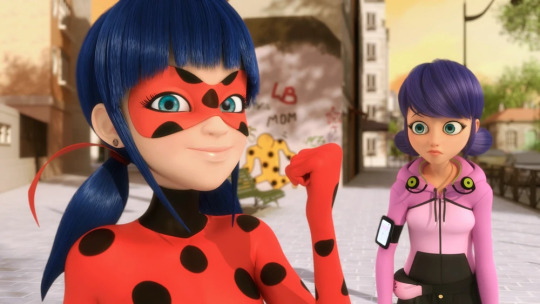
Is there a reason why the writers made this girl look almost exactly like Marinette? I feel like that would be important.

Look at the graffiti in the back. There’s LB, someone’s very passionate about their mother, and a Keith Haring man with Ladybug patterns?

Marinette actively uses her moped now. That’s good. The events of Chére Famille wasn't just an one-off, it had impacts on Marinette and on the narrative.
Out of curiosity, I did some research on driving laws in France, and Marinette can legally ride her moped. She’s definitely above fourteen.
New set design!

Very pretty new set. An art shop!

So this is how people are using their Alliance rings. Lila was right. Gabriel and Tomoe are geniuses, if, along with their nefarious purposes, they still managed to craft a compact form of technology that could completely revolutionise how people live their day-to-day life. Think of how children, the disable, and elderly could really benefit from this.
Socqueline does both tae kwon do and gymnastics. Those are very Ladybug activities. She certainly have the specs to be a mock-vigilante.
The average adult walks 4-5 thousand steps a day, most often even less. What kind of marathoning activities is Socqueline getting up to to rack up fifty thousand? And it's apparently not even noon yet. Girl was vigilanting as Ladybug by running around the city on foot.
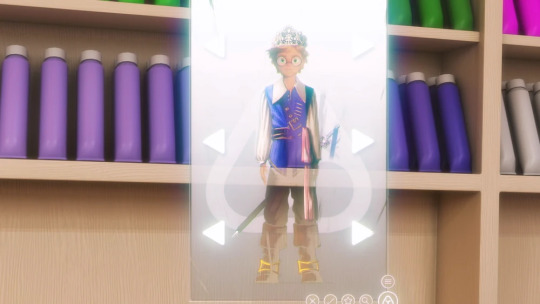
I cannot stress the ethical violations pertaining of Adrien’s digitalised form. It’s a cartoon, but that is the real image of an in-universe child being undressed and redressed like a doll. Gabriel, what are you doing? That’s your son.
Marinette, please don’t blurt out Adrien’s life story and deepest fears to a random person, even if that random person happens to be an old friend.
Dr Anne-Jeanne Théoxanne du Bocquale has such a specific name, design, and fixation. She’s bound to show up as an important character and not just as a side-gag repeatedly.
Marinette leaves with Socqueline’s ring on her finger. That’s going to bode well. Gabriel is likely hoping that Ladybug and Chat Noir will wear the Alliance rings, and their erratic physical activity or some other suspicious trigger will alert him of their identities.

Man is going through it.
Monsieur Damoclès really does look like an owl. Did they plan that into his character design, planning to debut him as the Owl all the back pre-Season 1?
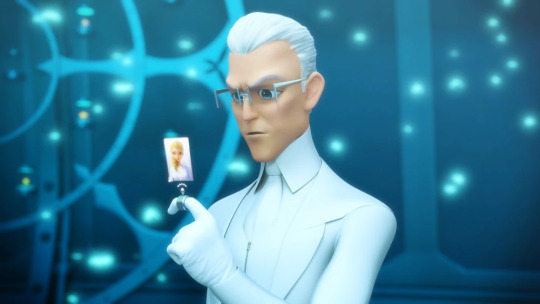
His avatar is Emilie. That is such a creepy and neat detail. Emilie’s model definitely isn’t publicly available. One has to wonder how Gabriel got Emilie’s features. Lila and Adrien he scanned, but Emilie? He took her measurements in her coffin/bed? Or was Emilie’s image already available pre-coma due to her vocation as an actress?
Firstly, Socqueline attends Claude Monet High School. That’s so pretty. Secondly, Socqueline won the Grand Prix gymnastics championship three years in a row?? Which Grand Prix? The global tournament one? In that case, I’ll start believing Socqueline is Ladybug too.
Also, called it. Ladybug’s erratic circle around Paris was noticed, immediately.

The Alliance rings also allow Monarque to be able to search for a perfect victim rather than waiting for their emotions to reach him! That is good! Monarque is really thinking in this season. These rings, not that Ladybug and Chat Noir knows are their enemy yet, is slowly pushing them into a corner. If either one of the decide to don one of these things, pretty soon it’ll be game over. Would Tikki and Plagg be able to sense the faint traces of Monarque in these rings should either Marinette or Adrien get them? Probably not.

And, boom, here we see that the power of the Miraculous themselves can be remotely transferred over the Alliance rings, no physical Monarque gifting ceremony necessary. These rings, if used properly, is going to win Monarque this battle.

Socqueline is clever.
Marinette thinks the reason why Grand Duc believes Socqueline to be Ladybug is because Socqueline cosplayed as her too many times. Marinette isn’t going to find out the truth of the Alliance rings for some time.

He’s so calm accepting this loss. Monarque has definitely matured. This classier attitude is more befitting of a terrifying villain. Someone who stays calm no matter how bad the situation is for them always send a chill down the protagonist and audience’s spine, because it feels like you’re being played no matter how the battle turns out. The protagonist could win, but they would still be thinking "but what if I only played into their hands?" Sephiroth from Final Fantasy VII is a good example of this type of villain. RIP Cloud’s mental psyche.
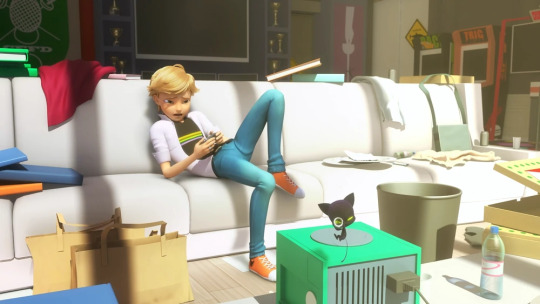
??? Dude, are you okay?

Both of them.

The citizens are viewing them from this angle because there’s not enough models to fill a crowd.
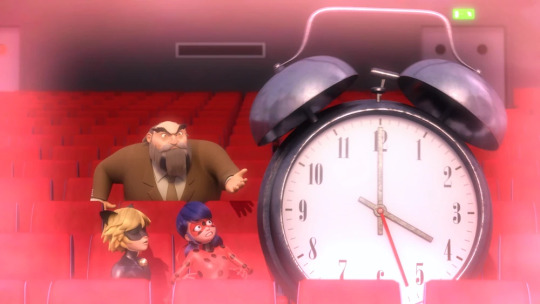
This is actually hilarious, this actually made me laugh.
So that’s what the Lucky Charm is for.

lmao.

Alewife.
"They ask me why I’m bringing" 🎶🎶 "A baby into battle. That’s really irresponsible, and getting them rattled."

That is the most horrifying child I’ver ever seen. We’ve seen baby models in Miraculous before (August), so clearly this is meant to emulate a doll. Paints the youthfulness of Chat Noir and Ladybug’s natures.

It gets funnier.

This Cadeau is both of their deepest desires, so they both want to end up together. It must be traumatic, to have years worth of good memories and fake living ripped from under oneself in a moment. And the famous umbrella theme is playing!
And their tears form into the rain!
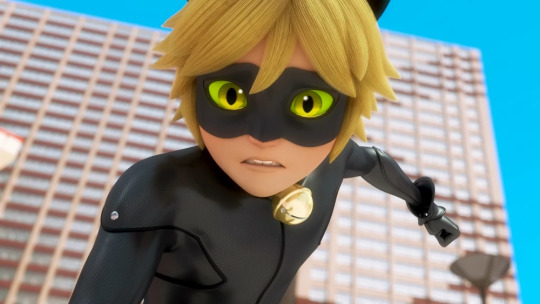
Yes!! Adrien manages to control his own emotions for once, without being aided by Ladybug or stopped at the last moment by some other interruption.
From both of their expression, I’m guessing they both remember the dream?

This is animal cruelty. Kwami cruelty.
Since the Kwami regains their powers from the nourishment of the food they eat, wouldn’t it benefit Gabriel to dish out some five-star treats? This is just unnecessary cruelty at this point. Maybe Gabriel is giving them slop to keep the Kwami purposely weak. Enough to charge up a new Champion, but not enough to start getting ideas.

"You’re already amazing, even without the suit." Yeah, girl. You won the gymnastics Grand Prix three years in a row. That’s a near impossible accomplishments. You’re practically superhuman.
Marinette gets gifted an Alliance ring, which must be expensive, and she rejects it immediately. Either she doesn’t like the fact that Adrien’s image is being handed out like free candy to every Dick, Tom, and Harry in Paris, or she’s getting vibes from it.
And Marinette explains the reasoning herself a second later! Good call, even if Gabriel isn’t the evil force behind the Alliance rings, physical data get sent back to the parent company all the time, for device optimisation or just archiving. Some random employee would realise, sooner or later, that the device which belongs to a certain person with unexplainable supernatural feats keep unleashing those feats in the same time and place Ladybug is active.
Lila appears once at the end of the episode, not even in person, just as her avatar. Yet, her image is at the centre of the endcard, violently salient with her all-white clothings amid an aureate background. There’s also a pronounced moment between her and Sabine. Foreshadowing that Sabine is going to be manipulated by Lila this season? Or that Lila’s scheming will hit the Dupain-Cheng family harder than ever this season?
And we get our second post-end card scene. Has these happened before? I don’t think so. It’s a good scene. Chat Noir and Ladybug are professionals, pondering the more life-threatening aspect of today’s queries first. The personal questions come after. But Ladybug is stout to deny that any of the dream – the wedding, babies, happily ever after – has anything to do with her true desires.
Monsieur Damoclès is the first true Akumatised villain this season, and he makes the debut with grandeur, sporting a new name, look, and brand new Miraculous power. He actually got pretty close to gaining Ladybug’s Miraculous too, which highlights the efficiency of this season’s Akumatised villains and Monarque’s better planning. Having the convenience of the Alliance rings and the versatility of the Kwami’s powers is going to force Ladybug and Chat Noir to edges they haven’t been before. In a way, Ladybug and Chat Noir barely won the battle. Grand Duc didn’t even fight back at the end. He seemed to be accepting that he has lost, and rather than continue futilely, decided to give it up and let Monarque try another day. Wonderful episode, makes me quite excited for more. How will other Champion fare against Ladybug and Chat Noir when they have new Miraculous powers on their side? Imagine Sapotis with Mirage, or Startrain with Voyage. Armed with the same abilities that defeated them in the first place.
#miraculous#season 5#jubilation#marinette dupain-cheng#ladybug#socqueline#chat noir#grand duc#monarque#review
7 notes
·
View notes
Quote
The closeness of the royal couple's relationship was reflected in the architecture of their living spaces. Mary Whiteley compares the physical space of royal palaces in England and France. Between 1357 and 1368, Edward III remodeled part of Windsor Castle, which formed the main residence for Philippa of Hainault and their children. Philippa had given birth to two of their children at Windsor, Margaret in 1346 and William in 1348, and Edward held a number tournaments there, two of which were in celebration of Philippa's churchings in 1348 and 1355. Although Philippa's rooms were smaller and fewer in number than those of the king, the king and queen's chambers were on the same level and their bedchambers close together, despite the facts that by the completion of Edward's renovations, Philippa had already borne her last child in 1355.
In comparison, the rooms that Jeanne de Bourbon (1338-78), wife of French king Charles V, occasionally stayed in at the Louvre palace were on the same level below that of her husband, although similar in size and shape. In their familial residences of St-Pol and Vincennes, Jeanne's rooms were in an entirely different building, although with a connecting corridor at St-Pol. The difference in architecture may be attributable to their preferences or the relationships between the couples.
Despite his changes to Windsor, during Edward's reign, the layout of the queen's rooms at palaces such as Westminster remained similar to their original design for Eleanor of Provence, wife of Henry III, at a distance from public areas. Likewise, at Kennington, Edward the Prince of Wales, built rooms for his wife [Joan of Kent] overlooking the gardens and away from the public areas, with no processional access and distanced from Edward's rooms. The layout remained unchanged under Richard II and Anne of Bohemia. As Richard favoured this palace, perhaps because of the connection to his father, the unaltered states may have been sentimental rather than practical. However, the general changes in the principal royal residences, which had transformed the fortified castles of the twelfth century into more luxurious palaces by the fourteenth century, also reflect the increase in royal splendour under Edward III and Richard II. Although differences between the palace layouts represent general patterns in royal architecture, the layout of Windsor does suggest that Edward intended to live close to Philippa.
— Louise Tingle, Chaucer’s Queens: Royal Women, Intercession, and Patronage in England 1328-1394 (pages 22 and 23)
#historicalquotes#history#english history#medieval history#14th century#edward iii#philippa of hainault#otp: all this shall be done#edward the black prince#joan of kent#otp: my dearest and truest sweetheart#richard ii#anne of bohemia#otp: truly devoted to thee#kings#queens#jeanne de bourbon#house of plantagenet#charles v#french history#historical quotes#*hquotes
46 notes
·
View notes
Text
Anne de Beaujeu
Anne de Beaujeu (Anne de France, 1461-1522)
Unofficial regent of France and duchess of Bourbon

Anne de Beaujeu provides an example of female political authority in a country where the Salic Law prevented women from assuming the crown. She also illustrates the tension between an increasingly centralized monarchy on the one hand and feudal independence on the other, having supported both causes at different times in her life. Probably born in 1461, Anne de Beaujeu was the oldest of the surviving children of Louis XI, king of France, and the one said to resemble him most intellectually and temperamentally. When this king died in 1483 leaving a thirteen-year-old Charles VIII on the throne, Anne and her husband, Pierre de Beaujeu, as his guardians, assumed control. In so doing, they resisted Louis d'Orléans, the next in line to the throne, who wished to be named regent. Louis and his supporters sought help from the estates-general who met in 1484 but who ultimately supported Anne's cause. Referred to as Madame la Grande (Grand Madam), Anne was recognized by the court and by foreign emissaries as the person actually ruling France during the early years of Charles's reign.
In 1488 she and Charles VIII squelched a noble uprising, the Guerre Folle (the Foolish War) led by Louis d'Orléans and Francis II duke of Brittany. Charles then married the new duchess of Brittany, Anne, to ensure the duchy's loyalty to France. Meanwhile Pierre de Beaujeu's two older brothers had died, leaving Pierre with the Bourbon inheritance. Anne and her husband were now the richest and most powerful nobles in France. In 1491, after the loss of one infant and fifteen years of childlessness, Anne gave birth to a daughter, Suzanne. As Charles VIII grew increasingly independent of his older sister, Anne redirected her attention to her own lands and feudal duties, though she remained his advisor while retaining her ties to the court. When Charles died suddenly in 1498 leaving no heirs, Louis d'Orléans became king of France. Neither his previous attacks on the crown nor his well-known personal vices inspired confidence in his subjects, so the support of Anne de Beaujeu and her husband were instrumental in a smooth accession to the throne. Anne agreed to overlook their antagonistic past and did not hinder the annulment Louis immediately requested from her physically disabled sister, Jeanne. In exchange, Louis XII waived the royal rights to the Bourbon inheritance in the case that Anne and Pierre did not have a male heir. Once all this had been established, the Bourbon's relationship with Louis XII and his new queen, Charles's widow Anne de Bretagne, became quite cordial. Anne de Beaujeu no longer held any direct influence, however, over the governance of the French state.
In 1504 or 1505, after the death of her husband and before she arranged a marriage for her daughter, Anne wrote Suzanne a book of lessons, Les Enseignements d'Anne de France, duchesse de Bourbonnois et d'Auvergne, à sa fille Susanne de Bourbon, modeled on the book that Louis IX had written for his daughter, the one her own father had written for Charles, and the writings of Christine de Pizan. Anne's version contains conventional advice on the appropriate behavior for noblewomen. During her unofficial regency, Anne had overseen the education of many young noblewomen at court, including Louise de Savoie, Marguerite d'Autriche, and Diane de Poitiers. The humble feminine figure that emerges from the Enseignements, however, seems at odds with their independent author. More easily recognizable are the anxieties about life as an older widow distant from court. The Enseignements ends with a tale about a noblewoman who bravely sacrifices her only child for the honor of her family and the interests of the king. Suzanne was, in fact, married shortly thereafter to a cousin to protect the integrity of the Bourbon inheritance.
In contrast to the moral of her tale, however, the interests of a noble family and those of the crown did not always overlap. Before she died, Anne witnessed the opposition of two adults whom she had raised from childhood: her son-in-law, the connétable de Bourbon, and Louise de Savoie, mother of Francis I, successor to Louis XII. Louise and her son, suspicious of the wealth and power of the connétable, the Bourbon heir, challenged his inheritance. After losing the domain that Anne had so carefully built up and defended during her lifetime, the connétable, perhaps with Anne's bitter approval, responded by betraying the French king Francis I- the other cause that Anne had defended so staunchly during her brother's reign. Anne died in 1522, before this ultimate betrayal.
Emily Thompson in Encyclopedia of Women in the Renaissance.
#xv#xvi#anne de france#anne de beaujeu#regents#duchesse de bourbon#louis xi#charles viii#pierre de beaujeu#louis xii#françois ii de bretagne#anne de bretagne#la guerre folle#suzanne de bourbon#sainte jeanne de france#louise de savoie#marguerite d'autriche#diane de poitiers#charles iii de bourbon#le connétable de bourbon#françois i#proof that anne approved of this ? i didn't find anything#the connétable's betrayal is a complex story#one can point fingers at françois i and louise de savoie too#emily thompson#encyclopedia of women in the renaissance
17 notes
·
View notes
Text
🇩🇰 Denmark. This time I will mention two films..
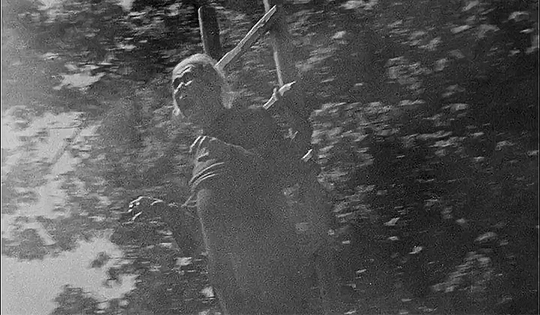
because both of them might arouse differing opinions about them, but are valuable in the history of Cinema.

Very slow-progressing Vredens Dag (1943) The Day of Wrath is based on a play by Hans Wiers-Jenssen from 1909. Director Carl Theodor Dreyer is best known for his film La Passion de Jeanne a’Arc (1928).
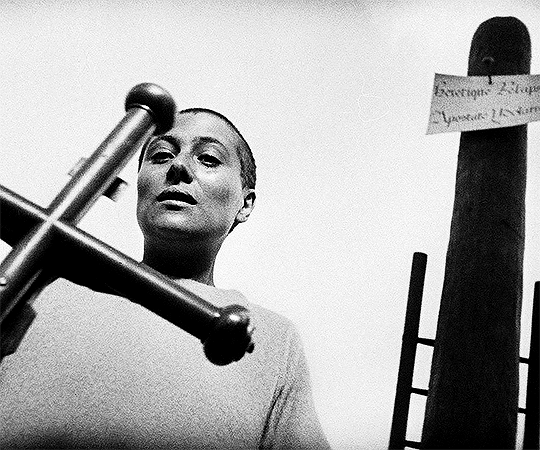
The film tells the story of a young woman Anne who is forced into a marriage with an elderly pastor Absalon after her late mother was accused of witchcraft. She falls in love with the pastor's son and also comes under suspicion of witchcraft. Absalon's son from his first marriage, Martin, returns home from abroad and he and Anne are immediately attracted to each other.

It has been said that the Day of Wrath reflects the times of the Nazi occupation of Denmark during which the film was completed. Dreyer has denied this. The original Play And this Film is talking about Anne Pedersdotter who was burned alive as a heretic. According to Levack (1987), the film actually does not repeat historical events but is otherwise a fairly good description of her trial and the early Norwegian witch trials.
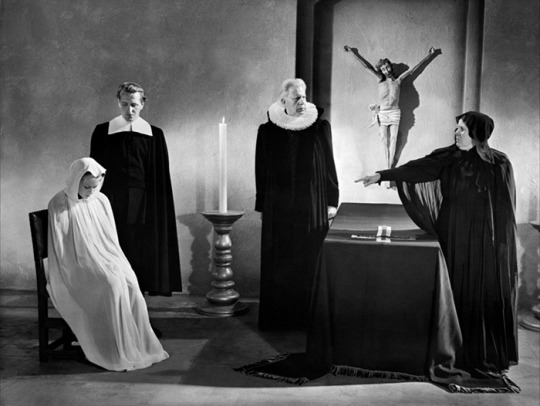
The 2nd movie is The Antichris♀(2009) by Lars von Trier.
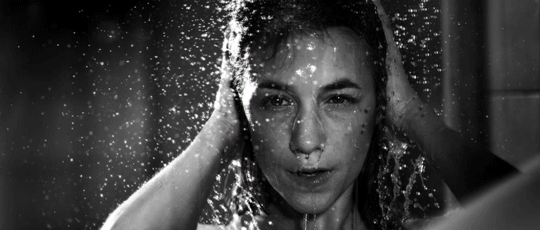
The opening scene of the film is incredibly beautiful and of course terrible and sad in content. It is accompanied by Händel’s Lascia ch’io pianga💜
youtube
After the child dies, The therapist man starts unethically taking care of his wife’s grief process and they end up in the woods. Instead of a recovery process, a journey begins deep into hopelessness and horror. Antichrist starts where the Blair Witch Project ended. And it doesn’t give the relief we get at the end of the Alien. Symbols no longer communicate😶
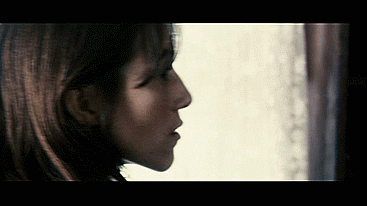
I remember walking from the cinema with a friend in deep silence. Usually we go to the beer after the movie, but this time I guess that too was passed🍺

Here, I think, is the side that Gammelgaard (2013) has aptly expressed:
”- - images regress into perverse scenarios, leaving the audience as defenseless spectors of death and destructiveness.” Sometimes this is very near that emotion when you are working in psychoanalytic psychotherapy with seriously traumatized patients…
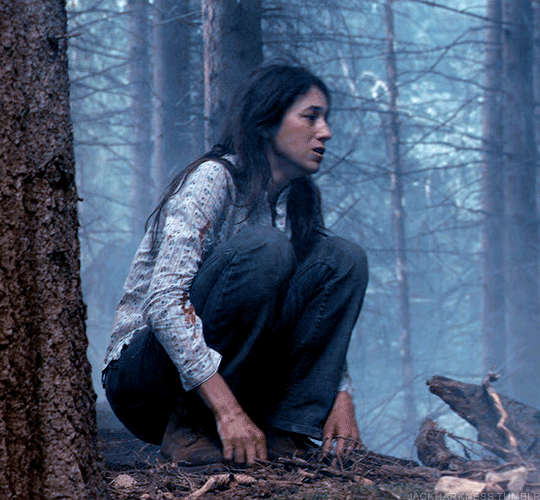
It may be that the mother of the film is not obvious ”bad” mother - the witch, but that there is the rejective mother behind this story, a depressed or lost mother who is expressionlessness and empty, manifest in the nature ”The Satan’s Church”🦊
Even if you haven’t lost a child, as in the movie, your own inadequacy can evoke exactly the same feelings of guilt that the parents go through. The man rationalizes everything. It’s a much more crushing feeling to face, the fact that there’s nothing you can do about the situation, it’s been out of my power. Something has happened to me for that I could not Do anything.

Trauma also arises from emotional rejection for which something could have been done. It is an unbearable idea that I was not desired, loved enough. In the end there are only witches🕷
Funny: When CBT therapist asks to list things😆
#witchcraft#movies#denmark#vredens dag#day of wrath#carl theodor dreyer#passion of jeanne d’arc#jeanne d’arc#witch#witch trials#history#cinema#lars von trier#antichrist#willem dafoe#charlotte gainsbourg#witches#film#horror#horror film#art#händel#norge
7 notes
·
View notes
Text





Eleanor Charlotte, Princess of Avon - State Opening of Parliament - 1890
In the above portraits we have Her Imperial and Royal Highness Eleanor Charlotte, Princess of Avon and Alexandria, Duchess of Montrose (nee Princess Eleanor Charlotte of Nassau) taken before the 1890 State Opening of Parliament where her husband Albert, Prince of Avon and Alexandria (heir to the Algarvian Throne) represented his mother Queen Augusta II who was still in deep mourning after the death of her husband Aribert, Prince Consort (1813-1890) (formerly Prince Aribert of Odessa; son of joint rulers Queen Jeanne I & King George I of Odessa) who died in January.
Princess Eleanor wore a black crepe mourning dress with her state robes and the sash and star of the Order of the Cerulean Star (highest order of chivalry in Algarvia), and the badges of the Order of Our Lady Maria (nassuvian female order) and the Order of Augusta II & I and Aribert. She dazzled with the Imperial Diamond Parure, which consisted of a diamond tiara; a cascade of diamond rivieres; a pair of diamond floral earrings and the large diamond Brooch (wedding gifts from her father Constantine I & IV, Berman Emperor & King of Nassau). She also wore Empress Wilhelmina’s Diamond Bow Brooches; and several diamond stars from the Algarvian Star Parure pinned to her dress.
Learn about the Future Queen Consort of Algarvia below.
Princess Eleanor Charlotte Helena Maria (known mostly as Eleanor) was born at the Royal Family's summer residence, Bellevue Palace in Nassau in 1843 as the youngest child and only daughter of Constantine I & IV, Berman Emperor and King of Nassau (then Constantine IV, King of Nassau; eldest son and heir of King Constantine III of Nassau and Helena of Odessa) and his consort Empress Charlotte (nee Charlotte, Princess Royal; youngest child and only daughter of Queen Caroline II of Algarvia and Andrew of Celle). She was born during the reign of her father, who ascended to the Nassuvian throne after the death of King Constantine III in 1830. As the only daughter of the then King and Queen of Nassau, she was doted on and spoiled lavishly by her family, and was a particular favorite of her grand aunt Princess Anne of Nassau. She had two elder siblings: Constantine, Crown Prince of Nassau (1827-1880 later Constantine II & V, Berman Emperor & King of Nassau) and Prince Andrew (later sovereign Duke of Anhalt). She enjoyed a very close relationship with both her parents and brother Prince Andrew; and never particularly got along with Crown Prince Constantine and detested his wife Crown Princess Maria. Queen Charlotte controlled the education of the young princess, which primarily focused on the history of royal families, diplomacy, etiquette and the arts as they wished for her to marry well and become the consort of an Emperor or King. It was said that Eleanor Charlotte was an exceptional girl; she was demure, even tempered, mature for her age and like her mother, she was musically and artistically inclined, although she wasn't much of an intellectual. She also enjoyed the outdoors, in particular horse riding and hunting and looked forward to spending summers in Algarvia with her maternal uncles and cousins.
Engagement:
Shortly after the birth of Eleanor Charlotte in 1843, discussions about the marriage of the princess were quickly underway. An arrangement was proposed for the engagement of Princess Eleanor Charlotte to her first cousin once-removed Prince Albert of Algarvia (eldest son of then Princess Augusta of Avon, later Augusta II), who at the time was third in line to the throne and set to become the future King of Algarvia after the deaths of his Great-Grandmother, Grandfather and mother. The pair saw each other frequently throughout their childhood and adolescence due to their close relations and were always fond of each other. This marriage would be of major political importance as it would help bring about reconciliation between the Kingdoms of Algarvia and Nassau, which began with the marriage of Eleanor Charlotte's mother and father. Algarvians and Nassuvians detested each other as a result of the War of Nassuvian Expansion (1800-1815), which saw Nassau gaining former Algarvian and Odessan territory after their crushing victory versus the Algarvians and Odessans. Eleanor Charlotte grew up to become one of the most beautiful Princesses of her time and was described to have an air of regal majesty about her. She was aware of her position and carried herself with dignity and elegance and impressed all who came into contact with her. She was presented at court in 1860 at the age of 17 and was extremely successful in capturing the attention of many suitors. In addition to Prince Albert, she had many other potential suitors, notably her paternal first cousin August, Hereditary Prince of Schwerin (later August I, Duke of Schwerin); the wealthy Hermann, Hereditary Grand Duke of Weimar (later Grand Duke of Weimar); and Ludwig, Hereditary Grand Duke of Merania. At the end of the court season in 1860, Prince Albert proposed to Eleanor Charlotte and she accepted, much to the delight of the Nassuvian court. News of their engagement sent shockwaves throughout Algarvia and Nassau and was received with mixed reviews as there was still lingering tension between the neighboring Kingdoms.
Marriage and Family:
Soon after their engagement, war broke out in late 1860 between Algarvia, Nassau and Odessa against the Savarian Empire, who were supported by Ciscily. The war was to be known as the Seven Years' War and lasted until late 1867. During this time Princess Eleanor Charlotte had moved to Algarvia to get accustomed to court life and to prepare for her future position as Princess of Avon under the tutelage of her first cousin and soon to be mother-in-law Queen Augusta II, who recently ascended to the throne after the death of her father King James II in June of 1860. She immersed herself in the war efforts and did a great deal to ease the suffering of the wounded soldiers. She became increasingly popular in Algarvia for her beauty, elegance, and generosity and fell in love with the idea of becoming Algarvia's future Queen. The relationship between the betrothed blossomed as they spent a great deal of time with each other and over the years formed a seemingly unbreakable bond. They narrowly escaped death as Wyndham Palace was bombed while several members of the Royal Family were in residence and had to flee to the Avon Islands to avoid any more attempts on their lives. Algarvia and her allies came out triumphant in the war and the couple were married in late 1868 (both of them now being 25) with an expensive wedding ceremony at Segrave Abbey, whereupon Eleanor assumed the titles Princess of Avon, Princess of Alexandria and Duchess of Montrose as the wife of the heir apparent. The wedding was attended by a plethora of foreign sovereigns and royalty as well as the local nobility and was described as the grandest wedding ceremony and largest gathering of royals in Algarvia's history. The Prince and Princess went on to have four children, including a set of twins:
His Royal Highness Prince James, Duke of Osorno (b. 1869)
His Royal Highness Prince Henry, Duke of St. James (b. 1869)
His Royal Highness Prince Carol, Duke of Carlisle (b. 1871)
Her Royal Highness Princess Louise Charlotte of Avon (b. 1888)
Princess of Avon:
As Princess of Avon, Eleanor Charlotte became a cultural icon, known for her fashion sense and charitable nature. As a lover of music, she co-founded the Segrave Conservatoire, a college for music and became patron of many other organizations, such as the Algarvian Red Cross. Shortly after their marriage, the Prince and Princess of Avon undertook a successful tour of the Algarvian Empire, including its overseas territories and Eleanor Charlotte completely overshadowed her husband and won the hearts of many people. She often deputized for the Queen, who suffered ill health for much of her life and in the words of Queen Augusta: "To spare me the strain and fatigue of functions, she opens bazaars, attends concerts, visits hospitals in my place. She undertakes her duties without complaint, and oddly enough seems to enjoy what to another would be a tiresome duty." She inherited her mother's love for jewellery and was often criticized by the public for her extravagance in which she remarked " If I were to dress common, what would the people look forward to when seeing me?". The Avons made Montrose Palace their preferred residence, with Mauchlar House being their Segrave (the country's capital) base. The marriage was happy by all accounts and the couple had three boys within their first three years of marriage, which made them extremely popular because the succession was well secured. After the birth of Prince Carol in 1871, Eleanor Charlotte was inflicted with rheumatic fever, nearly dying, and left her with a sort of limp that she tried her best to unsuccessfully conceal while undertaking public duties. During her pregnancies, the Prince of Avon was known to take mistresses, but was careful to be discreet about his affairs, which are unknown to Eleanor Charlotte, but was otherwise completely devoted to her. Eleanor Charlotte was a loving mother to her children and was in her glory when in the nursery tending to them. The Prince and Princess of Avon ensured that they played an active role in their development and spoiled them endlessly which caused friction between them and the steely eyed Queen Augusta. Eleanor Charlotte remained close to her relatives in Nassau and frequently visited with her children and they were doted on by their grand parents King Constantine and Queen Charlotte and were close to their Nassuvian cousins.
The Berman Empire and the Alisburg Bombings
Since the conclusion of the Seven Years' War, the deposed Emperor Ferdinand of Savaria was adamant on bringing down the Nassuvians, and after the assassination of his younger brother, Emperor Joseph Francis (1817-1874; r. 1870-1874), and his restoration to the throne, he declared war on Nassau which lasted from July 1874 to January 1875 and resulted in his second defeat. The former North Berman Confederation, which was headed by Savaria was overruled by a new constitution, implemented in 1875 under the permanent presidency of Nassau who was now the largest and most powerful state in Bermany. Constantine IV of Nassau was subsequently proclaimed Berman Emperor (as Constantine I) and president over the federation of 12 states and became one of the most powerful men in Ossetia. The Prince and Princess of Avon represented Algarvia at the proclamation in Nassau where Eleanor Charlotte, as the only daughter of the new Emperor, was sworn in as an Imperial Princess of the Berman Empire, a title she enjoyed exclusive privilege until her father's death. She was visibly moved at the ceremony and was extremely proud of her father's achievements. Five years later in 1880, Emperor Constantine celebrated his golden jubilee (50 years on the throne) as King of Nassau, and Eleanor Charlotte, who at the time was ill with a cold couldn't attend the festivities in Alisburg. During the Imperial Family's procession to Alisburg Cathedral for a service of Thanksgiving, Savarian nationalists hurled several bombs in the Emperor and Crown Prince’s path as they greeted locals, killing the Emperor immediately, while the Crown Prince sustained extensive injuries. News of his assassination sent shockwaves throughout the continent and Eleanor Charlotte fainted upon hearing the news. Her brother succeeded her father as Constantine II & V, Berman Emperor and King of Nassau, and reigned for a little over a year before succumbing to his injuries. Eleanor Charlotte was a great comfort to her mother (now Empress and Queen Dowager) and older brother Prince Andrew throughout the ordeal.
Presently
Within the early months of 1890, the Algarvian Royal Family experienced the tragic death of Aribert, Prince Consort (her father-in-law) in January, which plunged the Segrave Court into mourning. Queen Augusta II is deeply affected by the death of her husband and has been incapable of carrying out her public duties, which she delegated to The Prince and Princess of Avon. Eleanor Charlotte has essentially taken over the role of first lady and still carries out her duties with fervor. She spends a lot of time with her children and extended family and is a beloved figure in Algarvia and Nassau.
Titles and Styles:
(1843-1868) Her Royal Highness Princess Eleanor Charlotte of Nassau
(1868-1875) Her Royal Highness The Princess of Avon and Alexandria, Duchess of Montrose
(1875-present) Her Imperial and Royal Highness The Princess of Avon and Alexandria, Duchess of Montrose
14 notes
·
View notes
Note
What names did you want to use for your OCs, but decided against and why?
Hi anon, what a fun ask!
Wilhelmine, Wilhelmina, Wilhelm (all) - is a name I adore and was going to use as Eloise's name. Though, I decided against it due to historical monarchs named Wilhelm have not been good beans, to say the absolute least. I really like both masculine and feminine versions though ;-;
Odile (fem) - It's super cute ;-; I have no clue why not! I shall use it in gen 4 >:D
Elisbeth, Margarethe, Carl-Phillip, Eugenie, Leonor (all) - These are real life, currently existing royal names. I know I use Margarethe next gen, on purpose, though.
Phillippa, Helene, Henri, Sybille, Sofia-Amalia (all) - Some variations are too common on simblr, though I love them all. I went with Phillippe as a middle name next gen instead.
Bertil, Edouard, Morisot, Hyacinthe (masc) - I thought these were cute, but either too 'old' or 'short.' I regretted not using them, so I used them on @funkytrait . Mostly as middle names though, so that I can use them here in the future if desired.
Susannah, Jeanne (fem) - I have too many Anne names in my story, and I'm NOT giving up the reuse of Adrian in different spellings for a new Anne name.
Lauren, Ludwik, Claude (masc) - I used to enforce a two-child policy in my story, and I coin flip for birth-genders. There weren't enough boys for them to be used ;-;
5 notes
·
View notes
Text
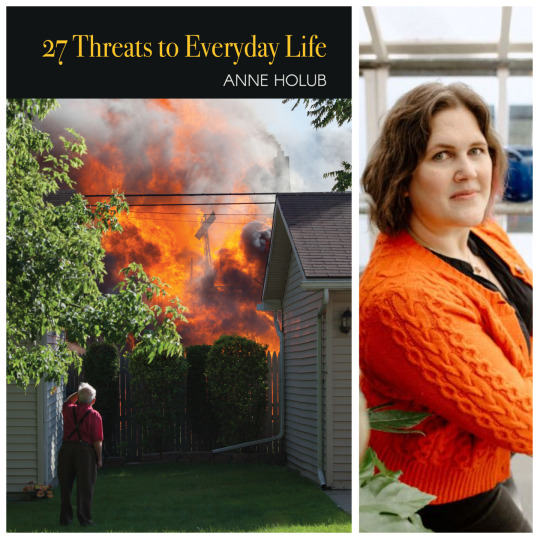
FLP CHAPBOOK OF THE DAY: 27 Threats to Everyday Life by Anne Holub
ADVANCE ORDER: https://www.finishinglinepress.com/product/27-threats-to-everyday-life-by-anne-holub/
As a child, did you used to leave the house with a caution and a warning from your parents? Drive safe! Be careful! What did you worry about when you walked alone in the dark? The chapbook, “27 Threats to Everyday Life,” explores everyday encounters with danger, fear, and survival through specific poems. This collection isn’t a study in morbidity, but instead examines living in a world where even small dangers can lead to catastrophe. Does the threat of danger keep you at home instead of taking risks? Or does even a life behind your door pose its own potential disasters? What have you forgotten to be afraid about?
Anne Holub received a MFA from the University of Montana and a MA from Hollins University. Her poetry has been featured on Chicago Public Radio and in The Mississippi Review, The Asheville Poetry Review, Phoebe and the anthology Bright Bones: Contemporary Montana Writing (Open Country Press 2018), among others. She lives and writes in Montana.
ADVANCE PRAISE FOR 27 Threats to Everyday Life by Anne Holub
Anne Holub’s extra-ordinary poems mark wayposts on a life examined with verve and smarts. They name fears we fear to name. They unfold questions. They do not flinch. Changing landscapes, memory, bees, the body’s gifts and vulnerabilities: they’re all here, and with them, the sweet surprises of the poet’s art—of well-chosen words, well shaped.
–Jeanne Larsen, author of What Penelope Chooses: poems
As is often the case with our most primal words, “threat” is an old one, and understandably so, with its denotation of impending danger, menace, or coercion — forces environmental, societal, and somatic that have accompanied human life since its beginnings. Anne Holub’s 27 Threats to Everyday Life offers a litany of such potential vexations, ranging from the personal and quotidian (dental plaque and insomnia, for example, or an air-conditioner “held high above with nothing / more than optimism /and a brick”) to the globally dire (mudslides, wildfires, floods, the corona virus). Sonically attuned to the inextricable links between humans and the world they inhabit, these poems are a bellwether, timeless and timely, offering, with a convincing dose of hope, both “a warning [and] a watch” for our imperiled moment.
–Lisa Russ Spaar, author of Madrigalia: New & Selected Poems
In a hazardous world, and across wild landscapes at once beautiful and threatening, Anne Holub‘s poems keep vigil. Even as they interrogate our notions of safety and wholeness, they find small mercies, too. This is a remarkable collection about the ways we survive, despite everything.
–Wendy McClure, author of The Wilder Life
Please share/please repost [PROMO]
#flpauthor #preorder #AwesomeCoverArt #poetry #chapbook #read #poems
#poetry#preorder#flp authors#flp#poets on tumblr#american poets#chapbook#leah maines#women poets#chapbooks#finishing line press#small press#book cover#books#publishers#poets#poem#smallpress#poems#binderfullofpoets
3 notes
·
View notes